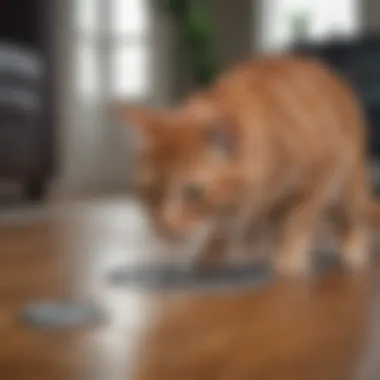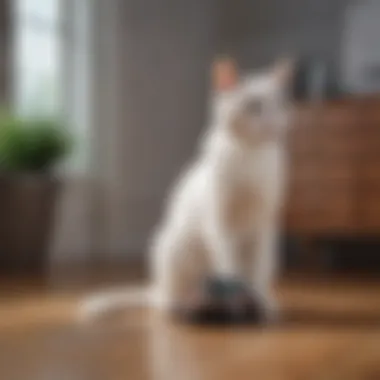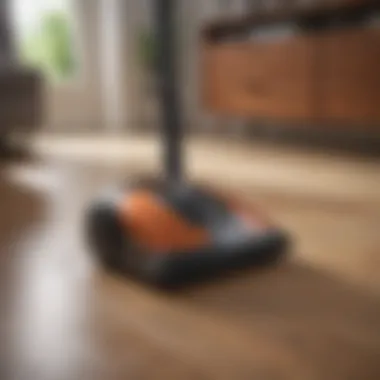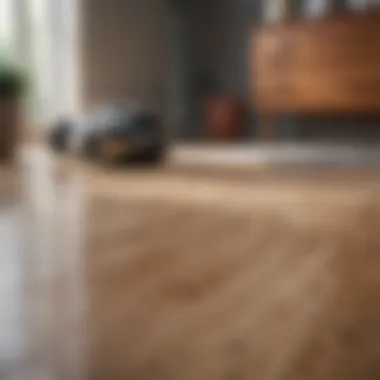Choosing the Best Vacuum for Cat Litter on Hardwood Floors


Intro
Selecting the right vacuum for cleaning cat litter on hardwood floors is a task of considerable importance. Homeowners with pets know that managing litter effectively is crucial. Not only for aesthetics but also for maintaining the integrity of hardwood surfaces. Cat litter can be abrasive and cause scratches if not cleaned properly. Hence, choosing a vacuum designed specifically for this purpose becomes essential.
This article will delve into various vacuums that excel in removing cat litter from hardwood. We will discuss pivotal aspects such as suction power, filtration systems, and the overall usability. By the end of this guide, readers will have a comprehensive understanding of how to select the best vacuum tailored to their unique cleaning needs.
Furthermore, it is vital to recognize the features that contribute to a vacuum's effectiveness. The right vacuum can simplify cleaning processes while ensuring that hardwood floors remain unblemished. Taking into account user-friendly features will also enhance the experience of cleaning in a pet-friendly home.
In this exploration, we will emphasize practical insights. These insights will stem from expert recommendations and user experiences. Homeowners, particularly those engaged in the dual role of pet ownership and interior maintenance, will benefit notably from this guide.
Understanding the Challenge of Cat Litter on Hardwood Floors
When you share your home with a cat, managing cat litter becomes a crucial aspect. The particles of litter can easily scatter and create a mess, especially on hardwood floors. This is an essential topic as it highlights the specific difficulties homeowners face in maintaining cleanliness while caring for pets.
The Nature of Cat Litter
Cat litter is designed to absorb moisture and control odors. It typically consists of various materials, such as clay, wood, or corn-based options. Each type has its pros and cons, affecting not just cleanliness but also maintenance. The granular nature of most litters can lead to it easily being tracked across floors. The small particles can cling to paws or get scattered during playtime or when the cat uses the litter box.
Moreover, certain litters produce fine dust. This dust can settle on surfaces, including hardwood, creating a layer of residue that may require regular cleaning. It's important to choose a litter that minimizes dust if you're aiming to reduce the overall mess.
Impact on Hardwood Surfaces
Hardwood floors are a stunning feature of many homes, yet they come with specific challenges, particularly when it comes to pet ownership. The most significant concern is the potential for scratches and stains caused by litter. Some cat litter materials can be abrasive, leading to dulling and damage over time. Fine particles can also work their way into the grain of the wood, making them harder to clean.
Additionally, moisture from certain types of litter can cause warping or discoloration of hardwood surfaces. It is critical to address spills or moisture immediately, as hardwood does not tolerate excess water very well. Therefore, homeowners must not only find effective cleaning solutions but also ensure that the vacuum chosen is suitable to protect the integrity of hardwood floors.
"A considerate selection of both cat litter and cleaning methods can prolong the life of your hardwood floors while providing a healthier environment for your pet."
In summary, understanding the nature of cat litter and its impact on hardwood is essential for maintaining a clean and beautiful home. It is vital to consider these factors when choosing a vacuum to ensure the best care for both your pet and your flooring.
Key Features to Look for in a Vacuum
Choosing the right vacuum for cat litter on hardwood floors is essential. Understanding the specific features that will enhance cleaning efficiency can avoid damage to both the floor and the vacuum. Cat litter can be stubborn, so specific components become crucial in the cleaning process. The following key features are fundamental.
Suction Power
Suction power is the core attribute when selecting a vacuum for cat litter. A powerful motor enhances cleaning capacity and makes it easier to pick up not only litter but also hair and dust. This characteristic is especially important for those who experience high-traffic areas. A vacuum with adjustable suction power can adapt to different types of debris, ensuring that fines can be captured as well as larger clumps of litter.
Brush Type and Design
The brush type and design directly influence how well a vacuum will perform on hardwood floors. Soft-bristle brushes are preferable since they do not scratch or damage the surface. Many vacuums come with brush roll technology that reduces scattering of debris. Some models feature a tangle-free brush which is beneficial to avoid hair wrap, an important consideration for cat owners.
Dustbin Capacity
Another significant feature is dustbin capacity. A larger dustbin helps to minimize the frequency of emptying, a critical factor when cleaning up larger volumes of cat litter. Compact dustbins might require more interruptions during cleaning sessions. It's wise to check how easy it is to remove and clean the dustbin, as a messy dustbin can negate the advantages of a good vacuum.
Filtration System
The filtration system is often overlooked but plays a vital role in maintaining indoor air quality. A high-efficiency particulate air (HEPA) filter is desirable when dealing with pet allergens. Such a filter can capture very small particles, which is especially relevant for households with allergy sufferers. Understanding how to maintain and replace filters also contributes to better vacuum performance over time.
"The right vacuum cleaner can make all the difference in the preservation of your hardwood floors and your quality of life as a pet owner."
In summary, each of these features contributes directly to the vacuum's effectiveness at managing cat litter on hardwood floors. Homeowners must assess these elements carefully to ensure they make the best investment for their cleaning needs.


Types of Vacuums Suitable for Cat Litter on Wood Floors
Choosing the right vacuum for cat litter on hardwood floors can significantly simplify your cleaning routine. Various types of vacuums cater specifically to this challenge. Each type offers its own set of benefits, considerations, and functionalities that align with your cleaning needs.
When selecting a vacuum, consider the type of litter your cat uses and the frequency of cleaning. Some vacuums are designed for quick cleanups, while others excel in thorough deep cleaning. It is essential to understand the different vacuum types available, so you can make an informed decision.
Upright Vacuums
Upright vacuums are popular for their power and efficiency. They tend to have strong suction, making them effective for picking up cat litter from hardwood floors. Because of their design, upright vacuums can cover large areas quickly, which is beneficial for homes with multiple rooms.
Many models feature adjustable suction settings and specialized attachments that enhance their capability to handle pet debris. This flexibility is essential, as hardwood floors require careful handling to avoid scratches. However, moving an upright vacuum across all areas may be cumbersome in tight spaces.
Canister Vacuums
Canister vacuums provide versatility. Their separate canister body allows for easier maneuverability around furniture. They can be more suitable for hardwood floors since they are often lighter and easier to control than upright vacuums. This type is particularly useful if you have varying surfaces in your home, such as carpets and tiles.
With a range of attachments, canister vacuums can be equipped to tackle cat litter effectively. Look for models with soft brushes to protect your hardwood. The dustbin capacity is also crucial; ensure it can handle the litter effectively without requiring frequent emptying.
Stick Vacuums
Stick vacuums have gained popularity due to their lightweight and cordless design. They are usually easy to store and quick to grab for a swift clean. Stick vacuums today often have powerful suction and specially designed heads that can handle both fine litter and larger debris.
However, while they are great for quick cleanups, they may not provide the same level of power as heavier models. They typically have smaller dustbins that may require more frequent emptying. Still, they are very effective in maintaining cleanliness on hardwood floors.
Robotic Vacuums
Robotic vacuums bring a modern touch to cleaning. They can autonomously navigate your home, making them an appealing option for busy homeowners. Many models are equipped with sensors to avoid obstacles and can be programmed to clean at specific times.
While robotic vacuums can effectively pick up cat litter, their performance can vary. Some may struggle with larger clumps of litter, so examining specifications carefully is vital. An additional advantage is that many come with washable filters, simplifying maintenance.
In summary, when selecting the right vacuum for cat litter on hardwood, consider each type's strengths and weaknesses. Assess your individual cleaning needs, such as storage space, usability, and maintenance. The suitable vacuum will significantly enhance your cleaning process and contribute to a more pleasant living environment.
Top Recommendations for Vacuums
Selecting the right vacuum can significantly enhance your cleaning effectiveness, especially when dealing with unique challenges like cat litter on hardwood floors. Understanding the various models and their distinct features is crucial. This section provides insights into three leading brands that excel in this area. With these informed choices, you will be well-equipped to tackle the mess associated with pet litter while protecting your hardwood surfaces.
Brand A: Overview and Features
Brand A has established itself as a reliable option for users seeking an efficient way to clean cat litter. Its highlighted features include a powerful suction mechanism that is effective on fine particles. This vacuum often comes with a specifically designed brush that minimizes scratches on hardwood flooring. Notably, its filtration system prevents dust and allergens from recirculating back into the environment. Users appreciate the ergonomic design, making it easy to maneuver around furniture and tight spaces. The combination of reliability and performance makes Brand A a popular choice among pet owners.
Brand B: Overview and Features
Brand B stands out with its innovative technology and ease of use. This vacuum model typically offers a dual-motor system, providing robust cleaning capability for both cat litter and other debris. The brush roll is designed to retract, which reduces the risk of annoying tangles from pet hair. A key benefit is its larger dustbin capacity, requiring less frequent emptying. Additionally, many users note its relatively lightweight design, making it suitable for frequent, quick clean-ups. The overall commendation of Brand B often focuses on its practicality in a busy household, especially those with pets.
Brand C: Overview and Features
Brand C is often regarded for its high-tech features, catering to modern cleaning needs. One of the outstanding elements is the vacuum’s smart sensor technology. It instantly adjusts the suction power depending on the surface type, ensuring optimal performance on hardwood floors versus carpets. A highlight of this vacuum is its quiet operation, which is a benefit in homes with pets and children. The ease of maintaining this model is another attractive quality, as many components are washable. Consequently, Brand C tends to receive high marks for versatility and innovation, appealing to tech-savvy consumers.
"Investing in the right vacuum can save time and ensure a cleaner home environment, especially where pets are involved."
With these top recommendations from trusted brands, you can select a vacuum suited for your unique needs. Each model has distinct benefits that resonate well with pet owners, particularly those operating in homes with hardwood flooring.
Price Considerations


When selecting a vacuum for cat litter on hardwood floors, understanding the price range is essential. Price often reflects the features and durability of a vacuum. Different consumers have varying budgets. It's crucial to identify which features matter most and how much you are willing to spend to get those benefits.
Investing in a vacuum can save time and maintain the aesthetic appeal of your hardwood floors. If a vacuum does not meet your expectations, it may result in additional expenses and frustration. Therefore, it is prudent to think critically about your budget before making a decision.
Budget-Friendly Options
Budget-friendly options usually range from $50 to $150. These vacuums can be effective for picking up cat litter if they have adequate suction power and appropriate brush designs. However, they may lack advanced features such as multi-surface capability or specialized attachments. While these models may not be the most powerful, they can serve well for individuals with limited budgets while maintaining reasonable performance. When choosing a budget model, ensure it has good reviews about its effectiveness on hardwood floors and litter type.
Mid-Range Choices
Mid-range models fall into the $150 to $300 category. At this price point, vacuums often deliver a balance of performance and features. They may include better filtration systems, larger dustbin capacity, and more durable components. These models can handle various cleaning tasks, from cat litter to general debris. Mid-range options provide better long-term value, as they tend to be more reliable and effective compared to budget counterparts. It's advisable to look for well-reviewed brands that specialize in pet owner-friendly features at this price level.
High-End Models
High-end models are priced above $300 and can go significantly higher, often exceeding $600. These vacuums are equipped with advanced technology such as strong suction power, specialized pet hair attachments, and efficient filtration systems that can reduce allergens. Many high-end options are designed specifically for pet owners, incorporating features that enhance usability and long-term cleaning effectiveness. Investing in a high-end vacuum can lead to less frequent replacements and reduced maintenance costs over time. For those seriously committed to maintaining their hardwood floors and minimizing pet-related mess, this investment could be worthwhile.
Maintenance and Upkeep of Vacuums
Maintaining and keeping your vacuum cleaner in good condition is essential for its longevity and effectiveness, especially when it comes to tackling cat litter on hardwood floors. A vacuum in poor condition can underperform, leaving behind dirt and litter that can scratch or damage your hardwood surfaces. Proper maintenance not only extends the life of your machine but also ensures optimal performance. Here, we delve into the specific maintenance practices that every vacuum owner should adopt.
Regular Cleaning of Filters
The filter is a critical component of a vacuum cleaner. It helps in trapping dirt, allergens, and dust particles, which improves air quality. Regularly cleaning or replacing your vacuum filters is vital. A clogged filter can reduce suction power and cause the machine to overheat.
To maintain the filters:
- Check often: Inspect the filters monthly. If they appear dirty, it’s time to clean them.
- Follow manufacturer instructions: Each model may have different filter types. Some can be washed, while others need replacement.
- Air dry: If washing, ensure the filters are completely dry before reinserting them into the vacuum, as moisture can lead to mold growth.
Keeping filters clean will ensure your vacuum works efficiently, making it easier to pick up cat litter and maintaining the integrity of your hardwood floors.
Emptying the Dustbin
Another essential aspect of vacuum maintenance is emptying the dustbin. A full dustbin limits the vacuum's ability to collect dirt and litter effectively.
Consider the following tips for dustbin maintenance:
- Frequent checks: Look in the dustbin after each cleaning session. It is important to empty it before it gets full.
- Avoiding clogs: If you vacuum large amounts of litter or debris, it’s a good idea to check the dustbin half-way through your cleaning process.
- Clean regularly: Dustbins should be cleaned out with warm water and mild detergent every few weeks to remove residues and prevent odors.
A clean dustbin promotes efficiency and collects cat litter and particles effectively, ensuring your hardwood floors remain pristine.
Checking and Replacing Brushes
The brushes of a vacuum cleaner play a significant role in the cleaning process, especially in picking up stubborn cat litter from hardwood floors. Over time, brushes can become worn or tangled with hair and debris.
To keep your vacuum functioning optimally:
- Inspect regularly: Check brushes every month for wear and tear or tangles.
- Clean after use: Remove hair and debris after each use to prevent clogging.
- Replace when needed: If the brushes show signs of damage or wear, it is essential to replace them to ensure effective cleaning.
Well-maintained brushes will ensure that the vacuum collects pet litter efficiently without scratching or harming your hardwood flooring.
"Proper maintenance can drastically improve a vacuum's performance, making it not just a cleaning tool, but a long-term investment in home care."
In summary, the upkeep of your vacuum cleaner should be an integral part of your cleaning routine. Regularly cleaning filters, emptying the dustbin, and checking brushes can greatly enhance the vacuum’s ability to handle cat litter on hardwood floors without compromising their quality.


Environmental Considerations
Choosing a vacuum cleaner is not just about efficiency; environmental considerations are essential in making an informed decision. In the context of selecting a vacuum for cat litter on hardwood floors, it is important to think about how your choice affects the planet. This section will cover energy efficiency and the use of sustainable materials, both of which play a significant role in reducing one’s carbon footprint while maintaining a clean home.
Energy Efficiency
Energy efficiency refers to using less electricity to accomplish the same cleaning tasks. When selecting a vacuum, look for models that have an Energy Star certification. These vacuums typically use about 30% less energy than standard options.
Using energy-efficient vacuums not only cuts down on electricity bills but also shows a commitment to environmental sustainability. Cat litter can be a nuisance, and tackling this issue while being energy-conscious makes a vacuum a worthy investment in both functionality and eco-friendliness.
Additionally, consider the power settings of the vacuum. Models with adjustable suction settings can save energy. If the vacuum can operate on lower power for lighter tasks, the environmental impact is reduced.
Sustainable Materials
Sustainable materials are crucial in today's consumer market. Vacuums made with recycled materials or components that can be easily recycled help mitigate waste. By choosing options with sustainable parts, users contribute to a circular economy, where products are reused and repurposed after their life cycle.
It is also worth noting how the manufacturing process of a vacuum cleaner can impact the environment. Brands that prioritize sustainable practices in their production, packaging, and shipping methods often have a reduced carbon impact.
"Selecting an environmentally friendly vacuum can enhance your cleaning routine and actively contribute to the health of the planet."
By understanding these environmental considerations, homeowners can make choices that align more closely with their values regarding sustainability.
User Experiences and Reviews
User experiences and reviews play a critical role in the selection process of vacuums designed for tackling cat litter on hardwood floors. They provide potential buyers with real-world insights that go beyond manufacturer specifications. These experiences help in understanding not just how well a vacuum performs, but also how it holds up over time under regular use. This information can significantly influence purchasing decisions, as it showcases the effectiveness and longevity of specific models in practical settings.
Common Praise for Effective Models
When it comes to user feedback, many vacuums receive consistent praise across multiple reviews for their performance. For instance, cat owners often commend vacuums that feature strong suction power, as this is crucial for picking up not just litter, but also hair and other debris that accumulate on hardwood floors. Models like the Dyson V15 Detect are frequently highlighted for their advanced suction technology that allows for effective cleaning without scratching the wood surface.
Users also appreciate vacuums that are lightweight and easy to maneuver, especially in homes with multiple rooms. Features such as a swivel head and a compact design make a big difference. Additionally, models with a specialized brush design that effectively minimizes litter tracking are often celebrated. It’s not uncommon for reviews to mention how a particular vacuum can quickly switch from hard surfaces to carpets, showcasing versatility in cleaning.
Reported Issues and Drawbacks
While there are many positive reviews, it is equally important to consider reported issues and drawbacks. A common problem noted by users relates to the noise levels of certain models. Some vacuums, particularly those with powerful motors, can be quite loud, which may be bothersome in a quiet household. For example, while the Shark Navigator is praised for its performance, it attracts criticism for being noisier than average during operation.
Another recurrent issue is the maintenance of filters and brushes. Users have pointed out that some vacuums require frequent filter replacements or cleaning, which can be inconvenient and increase long-term costs. There is also concern about the ease of emptying dustbins; models that are complex to manage or prone to dust spills when emptying can frustrate their owners.
Evaluating user reviews gives prospective buyers a comprehensive view of what to expect from different vacuums. Understanding both the strengths and limitations of a product is essential for making an informed choice.
End: Making the Right Choice
In the process of selecting a vacuum for cat litter on hardwood floors, conclusions drawn have the potential to significantly affect your overall cleaning experience. The features discussed throughout this article provide a framework to evaluate your cleaning needs accurately. Understanding the differences among various vacuum types, their design, and function allows you to choose one that aligns best with your lifestyle and preferences.
Weighing Features Against Needs
When choosing a vacuum, it is critical to assess your specific requirements. Not all vacuums are created equal, especially when it comes to handling cat litter on hardwood floors. Here are some key considerations:
- Suction Power: A strong suction is essential for effectively picking up litter without scattering it further. Vacuums with adjustable suction settings can be more versatile for various surfaces.
- Brush Configuration: The right brush type can make a difference in performance. Soft bristle brushes are typically more suitable for wood floors, as they avoid scratches, while still capturing debris.
- Filtration Efficiency: A vacuum with a high-efficiency particulate air (HEPA) filter reduces allergens as well as pet hair, providing a cleaner home environment.
- Weight and Maneuverability: Consider how easy the vacuum is to maneuver, especially if you have multiple rooms to clean. Lightweight models often allow for less fatigue during use.
Additionally, your personal lifestyle, such as whether you have children or other pets, can influence your choice. Prioritizing features like dustbin capacity can also be beneficial if you have frequent cleaning sessions due to litter mess.
Final Thoughts on Vacuum Selection
Concluding your search for the best vacuum requires some thoughtful deliberation. It’s not merely about acquiring the most expensive model. Rather, it is about finding a balance between quality and your specific needs.
When dealing with hardwood floors, protecting those surfaces should come first. Consider models that are specifically designed with features to ensure they do not damage the floor finish. Also, don’t forget to take into account how easy a vacuum is to maintain. Regular maintenance, including cleaning brushes and filters, will extend the lifespan of your chosen vacuum. It's a small time investment that reflects on the effectiveness of your cleaning.
The right vacuum serves not just as a cleaning appliance, but also as a tool to enhance the overall comfort and hygiene of your living space. As every home is unique, allow your needs to guide your selected choice. Ultimately, a thoughtful decision will lead to greater joy and cleanliness in your home.















